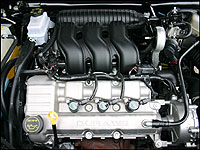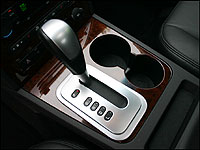Like the 300, the Five Hundred boasts American iron under the hood, albeit the 2.7-, 3.5-liter V6s and 5.7-liter HEMI V8 are only
 |
| Ford's 3.0-liter Duratec 30 can be found in everything from Ford's domestic Taurus, Ford of Europe's Mondeo, England's Jaguar X-Type and some miles away Japan's Mazda6. (Photo: Trevor Hofmann, Canadian Auto Press) |
beginning to enter European Chrysler dealerships while the 3.0-liter Duratec 30 can be found in everything from Ford's domestic Taurus, Ford of Europe's Mondeo, England's Jaguar X-Type and some miles away Japan's Mazda6, in different stages of tuning and refinement.
In Five Hundred trim the engine makes very little intrusive noise at all, which is ideal for this segment which values comfort over sport nine times out of ten. I mentioned this to Paul Mascarenas, Ford's Executive Director of Medium and Large Front-Wheel Drive Vehicles, who was on the ride with me and my co-driver, and he said the engine has gone through many stages of refinement to make it as smooth and quiet as it is. At its core are most of the trappings of top-tier powerplants, such as dual-overhead cam and 4-valve per cylinder architecture, but all the same there's nothing particularly outstanding with its final output numbers of 203 horsepower at 5,750 rpm and 207 lb-ft of torque at 4,500 rpm.
Then how does it sprint to 100 km/h quicker than a 250 horsepower V6-powered Chrysler 300? While there's a slight edge in curb weight, with the Ford fitter than the Chrysler by 27 kilos (57 pounds) in base trim, but that wouldn't make much of a difference when factoring in the Chrysler 3.5-liter engine's 43 lb-ft torque advantage. No, it comes down to the fact Ford chose a sophisticated European-source ZF-Batavia continuously variable transmission (CVT), or in upper models a 6-speed automatic, compared to Chrysler's rather archaic 4-speed gearbox. The CVT is optimal, keeping the engine's sweet spot constant while it adjusts the gearing ratio to increase speed. While there's a touch of slip at takeoff, or at least it feels like there is as it doesn't lock up like a conventional automatic,
 |
| To get the performance edge on Chrysler's V6-powered 300, Ford chose a sophisticated European-source ZF-Batavia continuously variable transmission, or in upper models a 6-speed automatic. (Photo: Trevor Hofmann, Canadian Auto Press) |
there's no mistaking the CVT's benefit during acceleration. I liked the way the 6-speed felt at takeoff better than the CVT, due to its initial punch, but the engineers made it clear the CVT is slightly quicker. The 6-speed benefits the Five Hundred in much the same way as the CVT, being that its shorter intervals allow the V6 to maintain optimal power. Chrysler's 4-speed unit hunts up and down noticeably, trying its best to find the best ratio to do the job but missing at least one in the process. Chrysler engineers recently confided in me that the reason V6 300s don't feature the 5-speed automatic that HEMI V8-powered 300Cs do, merely comes down to the inability for production to keep up. A 5-speed for V6-powered cars was promised to be on the way.

